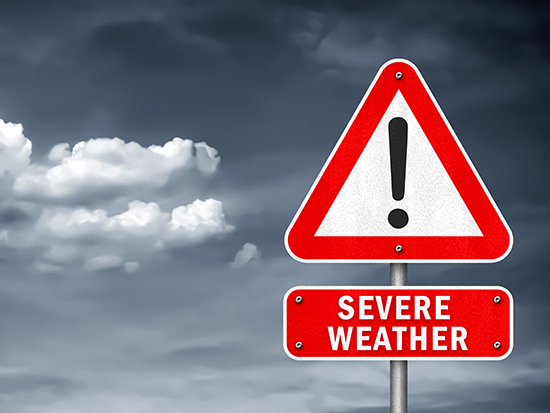
April showers bring May flowers. However, weather in April can be dangerous when severe weather strikes. Tornadoes and thunderstorms can cause serious damage, and UAB experts want to offer tips and ways to stay safe when severe weather arises.
Sheltering in place
Sheltering in place is a safety practice utilized when it is safer to remain inside a home, facility or work area until an unsafe situation passes in an external environment. This safety practice can mean the difference between life and death.
Safety where you are
According to the National Weather Service, flash floods are the No. 1 cause of deaths associated with thunderstorms.
Virginia P. Sisiopiku, Ph.D., professor in the Department of Civil, Construction and Environmental Engineering, says underestimating the depth of rainwater can lead to serious injuries and deadly situations.
“Just 12 inches of water is enough to sway your vehicle off course,” Sisiopiku said.
Even 6 inches of water can result in a driver’s losing control of their vehicle. UAB Medicine officials reiterate “Turn around; don’t drown” when water is on the roadways. Stay away from high water, storm drains, ditches, ravines and culverts.
When severe weather of any kind is predicted, the safest method of protection is to stay off the roads.
Click here to read more about what to do when caught on the road when severe weather strikes.
“We often notice congested conditions and lower driving speeds under adverse weather conditions due to slippery road surfaces, reduced visibility and increased likelihood of roadway crashes,” Sisiopiku said. “If you can avoid being on the roads during any period of severe weather, that is always the best option for your safety and the safety of others. Remaining in a secure location and sheltering is commonly what’s best for your safety and protection.”
Sisiopiku recommends utilizing state resources and watching out for local news updates to stay informed.
“Sources like ALDOT and local authorities are equipped to properly assess severe weather events,” Sisiopiku said. “Past events can provide a framework for what is expected for future scenarios, which is why it is crucial to adhere to any flash flood watches, warnings, or any severe weather warning broadcast or alert.”
Tornadoes
With wind speeds from 65 to 318 miles per hour, tornadoes are some of the deadliest forces of nature.
Safety during a tornado is sometimes contingent upon response times. Getting to safety or an appropriate shelter quickly can save lives.
When you are sheltering in place during a tornado, UAB Medicine officials suggest moving inside to a sturdy building or shelter when tornado watches or warnings are in effect. If possible, go to an underground shelter, basement or saferoom.
Nasim Uddin, Ph.D., professor in the UAB Department of Civil, Construction and Environmental Engineering, says research shows that structurally the interior of a structure is the safest in severe weather scenarios.
“Structurally, we see that some homes do not have the penetration resistance quality on the exterior perimeter to withstand against certain wind-borne debris,” Uddin said. “It is important to shelter in an interior room because even an exterior room with no windows can be susceptible to debris penetration from tornado wind speeds.”
For a list of approved storm shelter on-campus locations, click here.
According to Uddin, proper shelter-in-place procedures during a tornado should always be taken into consideration, and it is better to be properly prepared than to confront tragedy.
“There are a couple of different options for Alabama residents looking to improve the structural integrity of their homes,” Uddin said.
The Alabama Storm Shelter Tax Credit is a nonrefundable credit for the lesser of $3,000 or 50 percent of the cost of installation of a qualifying storm shelter under FEMA guidelines.
There are also grants available to homeowners that provide up to $10,000 to those who qualify to upgrade their single-family homes to protect against wind damage and debris.